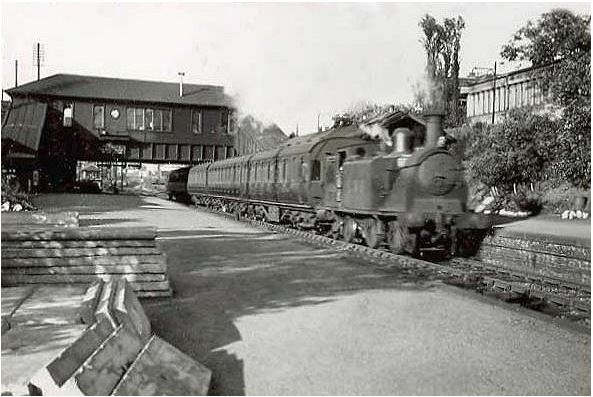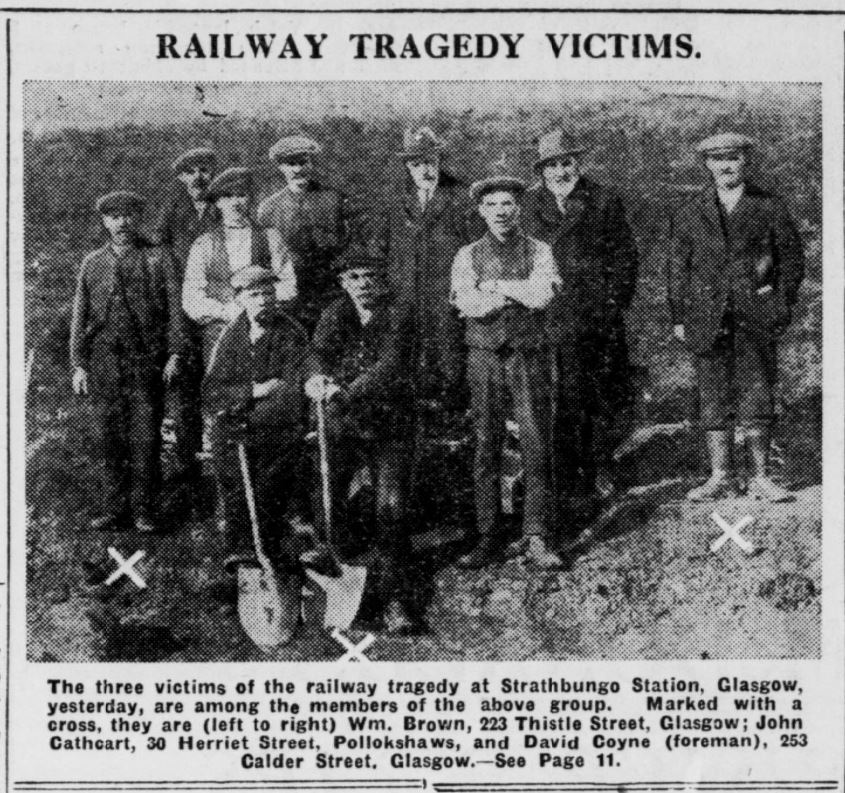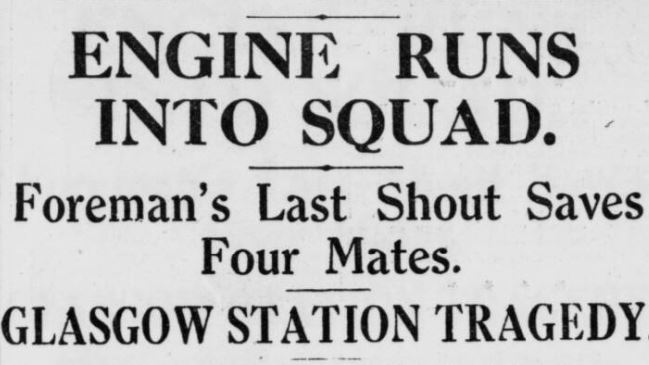On 14th February 1933 tragedy struck at Strathbungo Station.
It was just past 8am during the morning rush hour, and a gang of seven workmen were on the down line inspecting the permanent way and sleepers. David Coyne (56) was their foreman, and was acting as lookout. His colleagues were William Brown (64), John Cathcart (60, of nearby Herriet Street), Robert Wilson, Louis O’Neill, Francis Gallacher and James Carlisle.

An East Kilbride bound train in July 1948 at the down platform of Strathbungo Station, the scene of the tragedy in 1933. Photo: GH Robin / Mitchell Library
They stopped work to allow the Glasgow-Kilmarnock train to pass through, then returned to their duties. Meanwhile a Glasgow-bound train stopped at the opposite platform. As it departed a great cloud of steam billowed under the Nithsdale Road bridge on which the station office sat. The steam obscured the approach of a light engine proceeding south under the bridge and into the station, on its way to collect a train at Busby.
Coyne spotted the approaching engine and shouted “There’s an engine coming, boys, get clear”, but it was too late. The departing train on the other line had the men hemmed in. Three managed to jump into the narrow gap between the line and the base of the platform. “We were quite safe there and the engine passed us. We could hardly see it for the cloud of steam and smoke coming from the engine of the city-bound train which was passing under the bridge.”
Gallacher just had time to leap onto the platform, so close that his leg was grazed by the passing engine. He blamed the steam and smoke “I think they obscured the men’s view of the approaching engine. I myself could not see the engine, but I was far enough away to be able to jump on to the platform when I heard Coyne shout.”
Three were not so lucky. William Brown was pitched on to the platform right beside Gallacher, striking his legs, but was quite dead. After a lifetime working on the railway, he had been due to retire the following month. Coyne and Cathcart were knocked down and carried some distance under the engine, both killed instantly and badly mutilated.
Although the Daily Record initially reported the engine was quickly brought to a standstill, the driver John Gibson was actually unaware of what had happened and continued to Busby, only discovering the truth when he found blood on his engine and made enquiries.
The bodies were taken to the station waiting room, and hence to the Southern Police Mortuary.
Gallacher told a Dundee Evening Telegraph reporter “If I had stayed on the line for a moment longer I was for it. It was terrible to see my mates lying dead. I was just lucky enough to hear that shout and jumped in time” He added this particular squad had been known as one of the most careful working on the line, and he believed this was the first time that they had been involved in any kind of accident .

The permanent way gang, including the four victims, marked with crosses. Source: Daily Record 15 Feb 1933 / BNA
Inquiries
At an inquiry into the deaths, Sheriff Wilson heard from Robert Wilson, a survivor, and John Gibson the engine driver. The jury recorded a verdict of accidental death, adding that “no blame was attached to anyone” . I think we might investigate a little harder these days.
Meanwhile the railway investigators generated their own report, and reached a different conclusion, noting that Coyne had failed to keep a proper lookout, and indeed should not have been acting as lookout at all. Being the foreman, he should have appointed someone else to the job .
Previous
The railway accident database reveals that this wasn’t Coyne’s first accident. Back on 7 October 1924 he had suffered a bruised hip when struck by a passing train at Strathbungo Station that he had failed to notice approaching. The investigation attributed the accident to his negligence .
Acknowledgement
Thanks to the ‘Railway Work, Life & Death’ project, run by the University of Portsmouth, National Railway Museum and Modern Records Centre (www.railwayaccidents.port.ac.uk), from which the initial details of these railway worker accidents were taken. Please provide due acknowledgement if you reuse these details.
The railways were a very dangerous workplace in years gone by. The database records 1525 workforce casualties in forty years (1900-1939), with 405 fatalities. They still are; while the system is much reduced, and the statistical methods may be different, the Office of Rail and Road still reported 60 workforce deaths in the twenty years to 2024 .
References
{3557955:ZZKW8PVD},{3557955:T6X85MFU};{3557955:J76DKSIW};{3557955:B8E2D8ND};{3557955:B8E2D8ND};{3557955:R885FK63}
vancouver
asc
0
5036
%7B%22status%22%3A%22success%22%2C%22updateneeded%22%3Afalse%2C%22instance%22%3A%22zotpress-5b3a6186e9c4c9266c339daf9cfe7768%22%2C%22meta%22%3A%7B%22request_last%22%3A0%2C%22request_next%22%3A0%2C%22used_cache%22%3Atrue%7D%2C%22data%22%3A%5B%7B%22key%22%3A%22R885FK63%22%2C%22library%22%3A%7B%22id%22%3A3557955%7D%2C%22meta%22%3A%7B%22numChildren%22%3A1%7D%2C%22bib%22%3A%22%3Cdiv%20class%3D%5C%22csl-bib-body%5C%22%20style%3D%5C%22line-height%3A%201.35%3B%20%5C%22%3E%5Cn%20%20%3Cdiv%20class%3D%5C%22csl-entry%5C%22%20style%3D%5C%22clear%3A%20left%3B%20%5C%22%3E%5Cn%20%20%20%20%3Cdiv%20class%3D%5C%22csl-left-margin%5C%22%20style%3D%5C%22float%3A%20left%3B%20padding-right%3A%200.5em%3B%20text-align%3A%20right%3B%20width%3A%201em%3B%5C%22%3E1.%3C%5C%2Fdiv%3E%3Cdiv%20class%3D%5C%22csl-right-inline%5C%22%20style%3D%5C%22margin%3A%200%20.4em%200%201.5em%3B%5C%22%3ETable%205210%20-%20Workforce%20harm%20%7C%20ORR%20Data%20Portal%20%5BInternet%5D.%20%5Bcited%202024%20Nov%2018%5D.%20Available%20from%3A%20%3Ca%20href%3D%27https%3A%5C%2F%5C%2Fdataportal.orr.gov.uk%5C%2Fstatistics%5C%2Fhealth-and-safety%5C%2Frail-safety%5C%2Ftable-5210-workforce-harm%5C%2F%27%3Ehttps%3A%5C%2F%5C%2Fdataportal.orr.gov.uk%5C%2Fstatistics%5C%2Fhealth-and-safety%5C%2Frail-safety%5C%2Ftable-5210-workforce-harm%5C%2F%3C%5C%2Fa%3E%3C%5C%2Fdiv%3E%5Cn%20%20%3C%5C%2Fdiv%3E%5Cn%3C%5C%2Fdiv%3E%22%2C%22data%22%3A%7B%22itemType%22%3A%22webpage%22%2C%22title%22%3A%22Table%205210%20-%20Workforce%20harm%20%7C%20ORR%20Data%20Portal%22%2C%22creators%22%3A%5B%5D%2C%22abstractNote%22%3A%22%22%2C%22date%22%3A%22%22%2C%22url%22%3A%22https%3A%5C%2F%5C%2Fdataportal.orr.gov.uk%5C%2Fstatistics%5C%2Fhealth-and-safety%5C%2Frail-safety%5C%2Ftable-5210-workforce-harm%5C%2F%22%2C%22language%22%3A%22%22%2C%22collections%22%3A%5B%5D%2C%22dateModified%22%3A%222024-11-18T14%3A23%3A41Z%22%7D%7D%2C%7B%22key%22%3A%22T6X85MFU%22%2C%22library%22%3A%7B%22id%22%3A3557955%7D%2C%22meta%22%3A%7B%22parsedDate%22%3A%221933-02-14%22%2C%22numChildren%22%3A1%7D%2C%22bib%22%3A%22%3Cdiv%20class%3D%5C%22csl-bib-body%5C%22%20style%3D%5C%22line-height%3A%201.35%3B%20%5C%22%3E%5Cn%20%20%3Cdiv%20class%3D%5C%22csl-entry%5C%22%20style%3D%5C%22clear%3A%20left%3B%20%5C%22%3E%5Cn%20%20%20%20%3Cdiv%20class%3D%5C%22csl-left-margin%5C%22%20style%3D%5C%22float%3A%20left%3B%20padding-right%3A%200.5em%3B%20text-align%3A%20right%3B%20width%3A%201em%3B%5C%22%3E1.%3C%5C%2Fdiv%3E%3Cdiv%20class%3D%5C%22csl-right-inline%5C%22%20style%3D%5C%22margin%3A%200%20.4em%200%201.5em%3B%5C%22%3EThree%20Scots%20Platelayers%20Killed.%20Dundee%20Evening%20Telegraph%20%5BInternet%5D.%201933%20Feb%2014%20%5Bcited%202024%20Nov%2018%5D%3B%20Available%20from%3A%20%3Ca%20href%3D%27https%3A%5C%2F%5C%2Fwww.britishnewspaperarchive.co.uk%5C%2Fviewer%5C%2Fbl%5C%2F0000563%5C%2F19330214%5C%2F017%5C%2F0001%27%3Ehttps%3A%5C%2F%5C%2Fwww.britishnewspaperarchive.co.uk%5C%2Fviewer%5C%2Fbl%5C%2F0000563%5C%2F19330214%5C%2F017%5C%2F0001%3C%5C%2Fa%3E%3C%5C%2Fdiv%3E%5Cn%20%20%3C%5C%2Fdiv%3E%5Cn%3C%5C%2Fdiv%3E%22%2C%22data%22%3A%7B%22itemType%22%3A%22newspaperArticle%22%2C%22title%22%3A%22Three%20Scots%20Platelayers%20Killed%22%2C%22creators%22%3A%5B%5D%2C%22abstractNote%22%3A%22%22%2C%22date%22%3A%2214%20Feb%201933%22%2C%22section%22%3A%22%22%2C%22language%22%3A%22%22%2C%22ISSN%22%3A%22%22%2C%22url%22%3A%22https%3A%5C%2F%5C%2Fwww.britishnewspaperarchive.co.uk%5C%2Fviewer%5C%2Fbl%5C%2F0000563%5C%2F19330214%5C%2F017%5C%2F0001%22%2C%22collections%22%3A%5B%5D%2C%22dateModified%22%3A%222024-11-18T13%3A30%3A46Z%22%7D%7D%2C%7B%22key%22%3A%22B8E2D8ND%22%2C%22library%22%3A%7B%22id%22%3A3557955%7D%2C%22meta%22%3A%7B%22parsedDate%22%3A%222024-11-11%22%2C%22numChildren%22%3A1%7D%2C%22bib%22%3A%22%3Cdiv%20class%3D%5C%22csl-bib-body%5C%22%20style%3D%5C%22line-height%3A%201.35%3B%20%5C%22%3E%5Cn%20%20%3Cdiv%20class%3D%5C%22csl-entry%5C%22%20style%3D%5C%22clear%3A%20left%3B%20%5C%22%3E%5Cn%20%20%20%20%3Cdiv%20class%3D%5C%22csl-left-margin%5C%22%20style%3D%5C%22float%3A%20left%3B%20padding-right%3A%200.5em%3B%20text-align%3A%20right%3B%20width%3A%201em%3B%5C%22%3E1.%3C%5C%2Fdiv%3E%3Cdiv%20class%3D%5C%22csl-right-inline%5C%22%20style%3D%5C%22margin%3A%200%20.4em%200%201.5em%3B%5C%22%3ERailway%20Work%2C%20Life%20and%20Death%20%5BInternet%5D.%202024%20%5Bcited%202024%20Nov%2018%5D.%20Available%20from%3A%20%3Ca%20href%3D%27https%3A%5C%2F%5C%2Fwww.railwayaccidents.port.ac.uk%5C%2F%27%3Ehttps%3A%5C%2F%5C%2Fwww.railwayaccidents.port.ac.uk%5C%2F%3C%5C%2Fa%3E%3C%5C%2Fdiv%3E%5Cn%20%20%3C%5C%2Fdiv%3E%5Cn%3C%5C%2Fdiv%3E%22%2C%22data%22%3A%7B%22itemType%22%3A%22webpage%22%2C%22title%22%3A%22Railway%20Work%2C%20Life%20and%20Death%22%2C%22creators%22%3A%5B%5D%2C%22abstractNote%22%3A%22%22%2C%22date%22%3A%222024-11-11%22%2C%22url%22%3A%22https%3A%5C%2F%5C%2Fwww.railwayaccidents.port.ac.uk%5C%2F%22%2C%22language%22%3A%22en-US%22%2C%22collections%22%3A%5B%5D%2C%22dateModified%22%3A%222024-11-18T12%3A47%3A22Z%22%7D%7D%2C%7B%22key%22%3A%22ZZKW8PVD%22%2C%22library%22%3A%7B%22id%22%3A3557955%7D%2C%22meta%22%3A%7B%22parsedDate%22%3A%221933-02-15%22%2C%22numChildren%22%3A1%7D%2C%22bib%22%3A%22%3Cdiv%20class%3D%5C%22csl-bib-body%5C%22%20style%3D%5C%22line-height%3A%201.35%3B%20%5C%22%3E%5Cn%20%20%3Cdiv%20class%3D%5C%22csl-entry%5C%22%20style%3D%5C%22clear%3A%20left%3B%20%5C%22%3E%5Cn%20%20%20%20%3Cdiv%20class%3D%5C%22csl-left-margin%5C%22%20style%3D%5C%22float%3A%20left%3B%20padding-right%3A%200.5em%3B%20text-align%3A%20right%3B%20width%3A%201em%3B%5C%22%3E1.%3C%5C%2Fdiv%3E%3Cdiv%20class%3D%5C%22csl-right-inline%5C%22%20style%3D%5C%22margin%3A%200%20.4em%200%201.5em%3B%5C%22%3EThree%20men%20killed%20on%20railway.%20Daily%20Record%20and%20Mail%20%5BInternet%5D.%201933%20Feb%2015%20%5Bcited%202024%20Nov%2018%5D%3B%20Available%20from%3A%20%3Ca%20href%3D%27https%3A%5C%2F%5C%2Fwww.britishnewspaperarchive.co.uk%5C%2Fviewer%5C%2Fbl%5C%2F0000728%5C%2F19330215%5C%2F011%5C%2F0011%27%3Ehttps%3A%5C%2F%5C%2Fwww.britishnewspaperarchive.co.uk%5C%2Fviewer%5C%2Fbl%5C%2F0000728%5C%2F19330215%5C%2F011%5C%2F0011%3C%5C%2Fa%3E%3C%5C%2Fdiv%3E%5Cn%20%20%3C%5C%2Fdiv%3E%5Cn%3C%5C%2Fdiv%3E%22%2C%22data%22%3A%7B%22itemType%22%3A%22newspaperArticle%22%2C%22title%22%3A%22Three%20men%20killed%20on%20railway%22%2C%22creators%22%3A%5B%5D%2C%22abstractNote%22%3A%22%22%2C%22date%22%3A%2215%20Feb%201933%22%2C%22section%22%3A%22%22%2C%22language%22%3A%22%22%2C%22ISSN%22%3A%22%22%2C%22url%22%3A%22https%3A%5C%2F%5C%2Fwww.britishnewspaperarchive.co.uk%5C%2Fviewer%5C%2Fbl%5C%2F0000728%5C%2F19330215%5C%2F011%5C%2F0011%22%2C%22collections%22%3A%5B%5D%2C%22dateModified%22%3A%222024-11-18T12%3A46%3A23Z%22%7D%7D%2C%7B%22key%22%3A%22J76DKSIW%22%2C%22library%22%3A%7B%22id%22%3A3557955%7D%2C%22meta%22%3A%7B%22parsedDate%22%3A%221933-03-17%22%2C%22numChildren%22%3A1%7D%2C%22bib%22%3A%22%3Cdiv%20class%3D%5C%22csl-bib-body%5C%22%20style%3D%5C%22line-height%3A%201.35%3B%20%5C%22%3E%5Cn%20%20%3Cdiv%20class%3D%5C%22csl-entry%5C%22%20style%3D%5C%22clear%3A%20left%3B%20%5C%22%3E%5Cn%20%20%20%20%3Cdiv%20class%3D%5C%22csl-left-margin%5C%22%20style%3D%5C%22float%3A%20left%3B%20padding-right%3A%200.5em%3B%20text-align%3A%20right%3B%20width%3A%201em%3B%5C%22%3E1.%3C%5C%2Fdiv%3E%3Cdiv%20class%3D%5C%22csl-right-inline%5C%22%20style%3D%5C%22margin%3A%200%20.4em%200%201.5em%3B%5C%22%3ENo%20one%20to%20blame.%20Daily%20Record%20and%20Mail%20%5BInternet%5D.%201933%20Mar%2017%20%5Bcited%202024%20Nov%2018%5D%3B%20Available%20from%3A%20%3Ca%20href%3D%27https%3A%5C%2F%5C%2Fwww.britishnewspaperarchive.co.uk%5C%2Fviewer%5C%2Fbl%5C%2F0000728%5C%2F19330317%5C%2F006%5C%2F0006%27%3Ehttps%3A%5C%2F%5C%2Fwww.britishnewspaperarchive.co.uk%5C%2Fviewer%5C%2Fbl%5C%2F0000728%5C%2F19330317%5C%2F006%5C%2F0006%3C%5C%2Fa%3E%3C%5C%2Fdiv%3E%5Cn%20%20%3C%5C%2Fdiv%3E%5Cn%3C%5C%2Fdiv%3E%22%2C%22data%22%3A%7B%22itemType%22%3A%22newspaperArticle%22%2C%22title%22%3A%22No%20one%20to%20blame%22%2C%22creators%22%3A%5B%5D%2C%22abstractNote%22%3A%22%22%2C%22date%22%3A%2217%20Mar%201933%22%2C%22section%22%3A%22%22%2C%22language%22%3A%22%22%2C%22ISSN%22%3A%22%22%2C%22url%22%3A%22https%3A%5C%2F%5C%2Fwww.britishnewspaperarchive.co.uk%5C%2Fviewer%5C%2Fbl%5C%2F0000728%5C%2F19330317%5C%2F006%5C%2F0006%22%2C%22collections%22%3A%5B%5D%2C%22dateModified%22%3A%222024-11-18T12%3A45%3A07Z%22%7D%7D%5D%7D
Like this:
Like Loading...




Leave a Reply